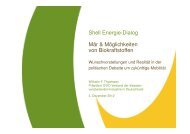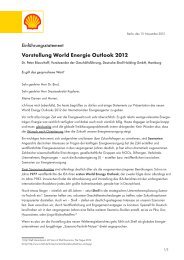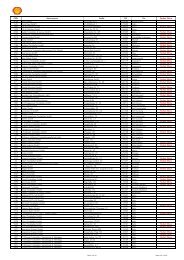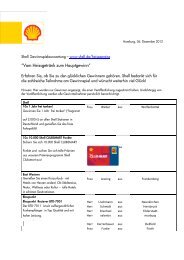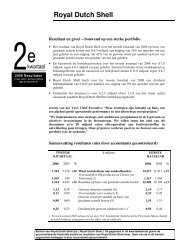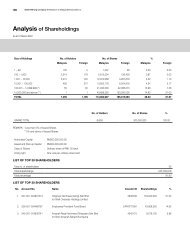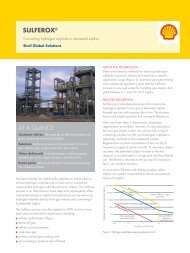ENVIRONMENTAL STATEMENT BARDOLINO DEVELOPMENT
ENVIRONMENTAL STATEMENT BARDOLINO DEVELOPMENT
ENVIRONMENTAL STATEMENT BARDOLINO DEVELOPMENT
Create successful ePaper yourself
Turn your PDF publications into a flip-book with our unique Google optimized e-Paper software.
Bardolino Development Environmental Statement<br />
It is likely that the noise effects of the vessels associated with the proposed activities would<br />
be similar in character to normal commercial shipping activities. Consequently, cumulative or<br />
global impacts would be unlikely.<br />
6.7.5 Consultee concerns<br />
During the informal consultation process (Section 1.6), JNCC advised that within the ES,<br />
Shell should consider whether any of the proposed activities are likely to cause 'deliberate<br />
disturbance’ to a European Protected Species (EPS). JNCC advised that whilst Shell needed<br />
to carry out the assessment, the use of mitigation measures (including the use of a Marine<br />
Mammal Observer (MMO), the restriction of piling activities to daylight hours, and those other<br />
measures included within the Shell agreed procedure for offshore piling activities), are likely<br />
to be sufficient mitigation measures to ensure that the proposed activities do not cause<br />
disturbance to any EPS.<br />
6.7.6 Adequacy of proposed mitigation measures<br />
Noise during the Bardolino development activities would be generated underwater primarily<br />
by piling activities during the installation of the manifold, production tree and valve skid. The<br />
duration of the main piling activities will be around 24 hours in total, over two periods of<br />
activity. Modelling has shown that various species of marine mammals within 10 m to 1.5 km<br />
of the site could experience received noise levels that might cause a strong avoidance<br />
reaction (Table 6.11); that is, the animals would move away from the source of noise.<br />
Evidence suggests, however, that marine mammals disturbed temporarily in this way would<br />
readily move back into the area once the noise ceased.<br />
The area in which marine mammals might be exposed to received noise levels that might<br />
elicit a strong avoidance reaction is very small in comparison with the area of the central<br />
North Sea. The densities of marine mammals in this area are low, and the proposed period<br />
for piling does not coincide with any peaks of marine mammal abundance (Section 4.4.4). It<br />
is therefore expected that the overall potential impact of piling operations, even without the<br />
mitigation measures described below, would not be significant.<br />
Modelling has also shown that the area within which received noise levels may be loud<br />
enough to cause a TTS would extend to approximately 50 m for a Minke whale, and that<br />
piling noise would not be expected to result in a TTS for harbour porpoise, bottlenose dolphin<br />
or killer whale (Table 6.11). The mitigation measures that the project would employ would be<br />
designed to ensure as far as possible that piling did not begin while marine mammals were<br />
within this zone, that marine mammals were gradually exposed to increasing levels of noise<br />
so that they could move away from the source of noise, and finally that piling would be halted<br />
if marine mammals were observed within a pre-defined zone around the site.<br />
The JNCC has developed guidelines for use during seismic survey operations, and these can<br />
be modified and applied to piling operations in order to reduce the likelihood that marine<br />
mammals would be exposed to significantly elevated noise levels. Shell has developed a set<br />
of guidelines in line with the JNCC guidelines, to be used for all offshore piling operations<br />
within the UKCS (Shell, July 2007). These procedures are included in Appendix 4. These<br />
Guidelines for Minimising Acoustic Disturbance to Marine Mammals from Piling Operations<br />
have been discussed and agreed with JNCC, and will be followed during the piling operations<br />
at Bardolino. Important mitigation features from these guidelines, that would be incorporated<br />
into the Bardolino piling operations, are:<br />
• Piling would only begin during daylight hours.<br />
• A qualified and experienced marine mammal observer (MMO), whose suitability has<br />
been agreed with the JNCC prior to the operation, would be present on the standby<br />
vessel throughout the operations, to monitor the presence of marine mammals in the<br />
area.<br />
April 2008 Page 6-31


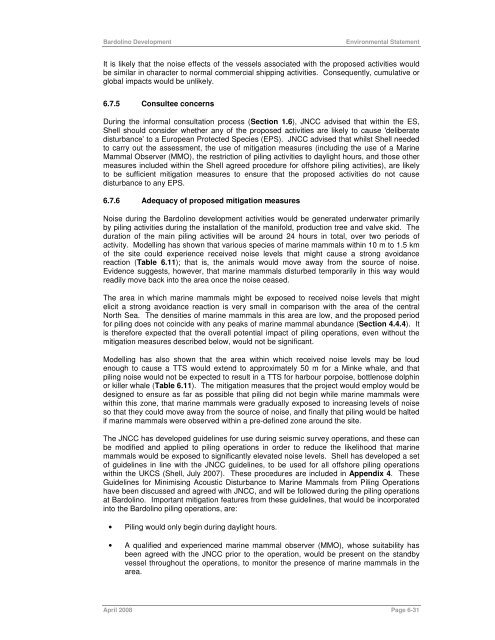

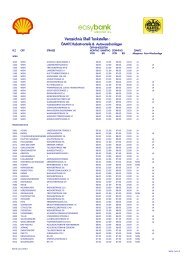
![Download Shell AutoGas Stationen [Stand: Januar 2013] (PDF](https://img.yumpu.com/9982753/1/190x245/download-shell-autogas-stationen-stand-januar-2013-pdf.jpg?quality=85)
